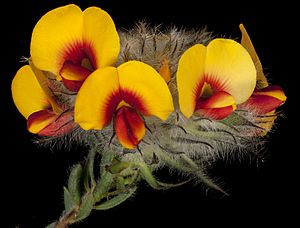Urodon dasyphyllus facts for kids
Quick facts for kids Urodon dasyphyllus |
|
|---|---|
 |
|
| Scientific classification | |
| Genus: |
Urodon (plant)
|
| Species: |
dasyphyllus
|
| Synonyms | |
|
Phyllota lycopodioides S.Moore |
|
Urodon dasyphyllus, also known as the mop bushpea, is a small shrub. It belongs to the Fabaceae family, which includes peas and beans. This plant grows only in the southwest part of Western Australia.
What Does It Look Like?
The mop bushpea is a shrub that looks a bit like a broom. It can grow straight up, spread out, or even climb. Its stems are round and hairy, without any sticky parts.
The leaves are simple and grow one after another along the stem. They have smooth edges and are about 8–11 mm long and 1.5–2.5 mm wide. They grow on hairy stalks that are 3–6 mm long. Even the newest leaves don't seem to have small leaf-like parts called stipules.
Small, hairy, leaf-like parts called bracteoles are 8–10 mm long and stay on the plant. The outer part of the flower, called the calyx, is hairy and smooth, without any bumps or sticky glands.
The petals, known as the corolla, are 14 to 16 mm long. The top petal, called the standard, is 11–16 mm long and smooth. The side petals, or wings, are 11–12 mm long. The bottom petals, called the keel, are 12–13 mm long and are not pointy.
Each flower has ten stamens, which are the male parts. The anthers, which hold pollen, are 0.8 to 1 mm long. Their stalks, called filaments, are alternately long and short.
The ovary, where the seeds grow, is hairy or sticky. The style, part of the female organ, is hairy or sticky near its base. It is 10–11 mm long and round.
The fruit has almost no stalk and is round. It opens when it is ripe to release the seeds.
This plant flowers in July, August, September, October, and December.
Where Does It Grow?
The mop bushpea grows in several areas of Western Australia. These areas are part of the IBRA regions. You can find it in the Yalgoo, the Murchison, the Coolgardie, the Geraldton Sandplains, the Avon Wheatbelt, and the Jarrah Forest.
About Its Name
The mop bushpea was first described in 1853 by a scientist named Nikolai Turczaninow.
Its scientific name, dasyphyllus, comes from two ancient Greek words. "Dasys" means "hairy," and "phyllon" means "leaf." So, dasyphyllus means "hairy-leaved," which describes the plant's leaves.
Conservation Status
Good news! Under Western Australian conservation laws, the mop bushpea is considered "Not threatened." This means it is not currently at risk of disappearing.

